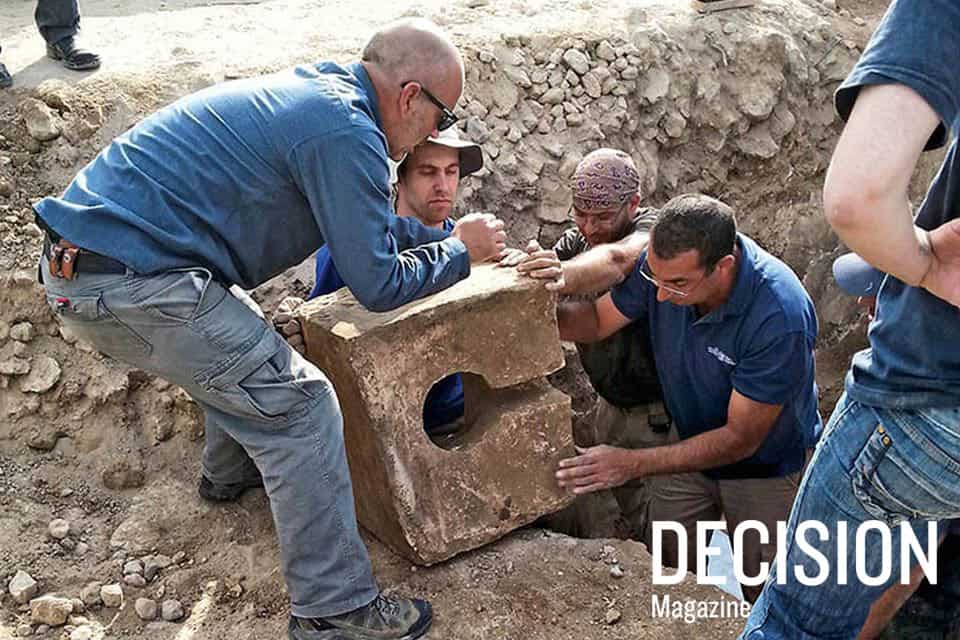
And they demolished the pillar of Baal, and demolished the house of Baal, and made it a latrine to this day. (2 Kings 10:27)
A toilet dating to the 8th century B.C. in the excavated ruins of the ancient Israelite city of Lachish is not the “latrine” mentioned in 2 Kings that Jehu used to desecrate the Baal altars in Samaria. But the toilet discovery, announced in 2016 by the Israeli Antiquities Authority, lends credence to Old Testament accounts like 2 Kings 10:27, and enriches the faith of modern Christians.
That’s the assessment of two evangelical scholars whose work in teaching future pastors and missionaries is largely informed by such archaeological finds.
Professors Steven Ortiz and Gordon Johnston are both quick to note that archaeology doesn’t “prove” the Bible’s divine nature. Yet, they agree, it is a spiritual tool in the hands of a prepared Christian seeking ways to interact with everyday people.
Subscribe to Decision
Get your own subscription, or renewal, or bless someone by giving Decision Magazine as a gift.
SUBSCRIBE NOW
Under the reforms of kings such as Hezekiah, the desecration of pagan worship sites appears to have been strongly punctuated to remind the Hebrews: You shall have no other gods before Me. And such findings can serve to embolden believers to use Biblical archaeology as a bridge to evangelistic discussions.
“Most people are interested in history,” explains Ortiz, director of the Charles D. Tandy Institute of Archaeology at Southwestern Baptist Theological Seminary in Fort Worth, Texas. “Some will view the Bible as a collection of religious writings or a collection of myths. But when a person is confronted or exposed to the fact that these were real people that were engaging with a real God, they must respond.”
Johnston, professor of Old Testament Studies at Dallas Theological Seminary, says he has seen at least one instance where a discussion about Biblical archaeology led a skeptic to delve into the claims of Scripture. The man became a Christian eventually.
“Archaeology may show that the events took place the way the Bible describes,”
Johnston says, “so it may support its basic historicity.” And that can be a crucial starting point for unbelievers.
The dig at Lachish was begun in the 1930s and continued on and off since then. The latest excavation, in conjunction with the Israel Antiquities Authority, has continued to uncover remnants of Biblical importance.
The ancient toilet, unveiled publicly late last summer, is noteworthy for its placement inside what is thought to have been a pagan shrine built for Canaanite worship prior to Joshua’s conquest of Lachish (Joshua 10:31-32).
The find is consistent with the historical records of King Hezekiah’s religious reforms in Judah in the late 8th century B.C. (2 Kings 18:4; 2 Chronicles 29:32), his effort to return temple worship to Jerusalem, and his resistance against the encroachment of the Assyrians.
Lachish, located between Mount Hebron and the Mediterranean Sea and mentioned 24 times in the Old Testament, was considered the second most important city in Judah, next to Jerusalem, according to scholars. Its excavation has revealed a large, six-chambered city gate where the pagan shrine was found, and where business transactions would have occurred. According to an article at history.com, the city gate complex was 80 feet by 80 feet with the city’s main road bisecting the six-chambered structure.
—Gordon Johnston
In addition to the toilet used to desecrate the worship site, the horns of a four-horned altar had been broken off—another practice employed by the ancient Jews to signal a return to worshiping only Yahweh. The horns signified a deity’s power.
Ortiz, who is also the lead archaeologist at Tel Gezer in Israel, worked at Tel Lachish as a Ph.D student in the 1980s and has visited there many times since.
He says the placement of the toilet on the worship site “would have had a harsher impact than just a statement about not worshiping ‘other gods.’ Hezekiah was drawing a line in the sand: You can only serve Yahweh. He was making a statement that the king and kingdom were going to serve God and rely on Him for salvation from Assyria. There was probably also a statement here that true worship was in Yahweh’s house in Jerusalem, and not anywhere else.”
Johnston suggests this kind of desecration effectively proclaimed that this false god must no longer be worshiped at the shrine.
“By breaking the horns of the altar, and by symbolically desecrating it with a ceremonial toilet—which was likely never used—the place was no longer sacred for that deity.”
Johnston notes that God’s prescriptions for the Hebrew armies give a glimpse of the vast gulf between God’s holiness and man’s earthiness (Deuteronomy 23:12-14). For example, the Israelite soldiers were not allowed to relieve themselves inside the camp, but were ordered by God to go beyond the camp, and then to bury their waste—because Yahweh walked among them and He was holy.
“We find the topic of using the bathroom kind of offensive and embarrassing to talk about, so yes, it would have certainly been a way to desecrate the rival deity,” Johnston says.
Each time an archaeological find confirms Biblical descriptions, it ties those descriptions to historical events, which ultimately aids the work of the church, Ortiz says.
“Christianity is unique because it is based on historical events—God acting in history,” he says. “The passion of our Lord and our salvation—the work of the cross, for example—are based on these events happening. That is, the crux of the Gospel story is not necessarily the teachings of a first-century rabbi, but that God sent His Son, in a specific time and cultural context, to die for our sins on a cross. Hence, the church’s emphasis and interest in archaeology and the events of the past.” ©2017 BGEA
Give To Where Most Needed
